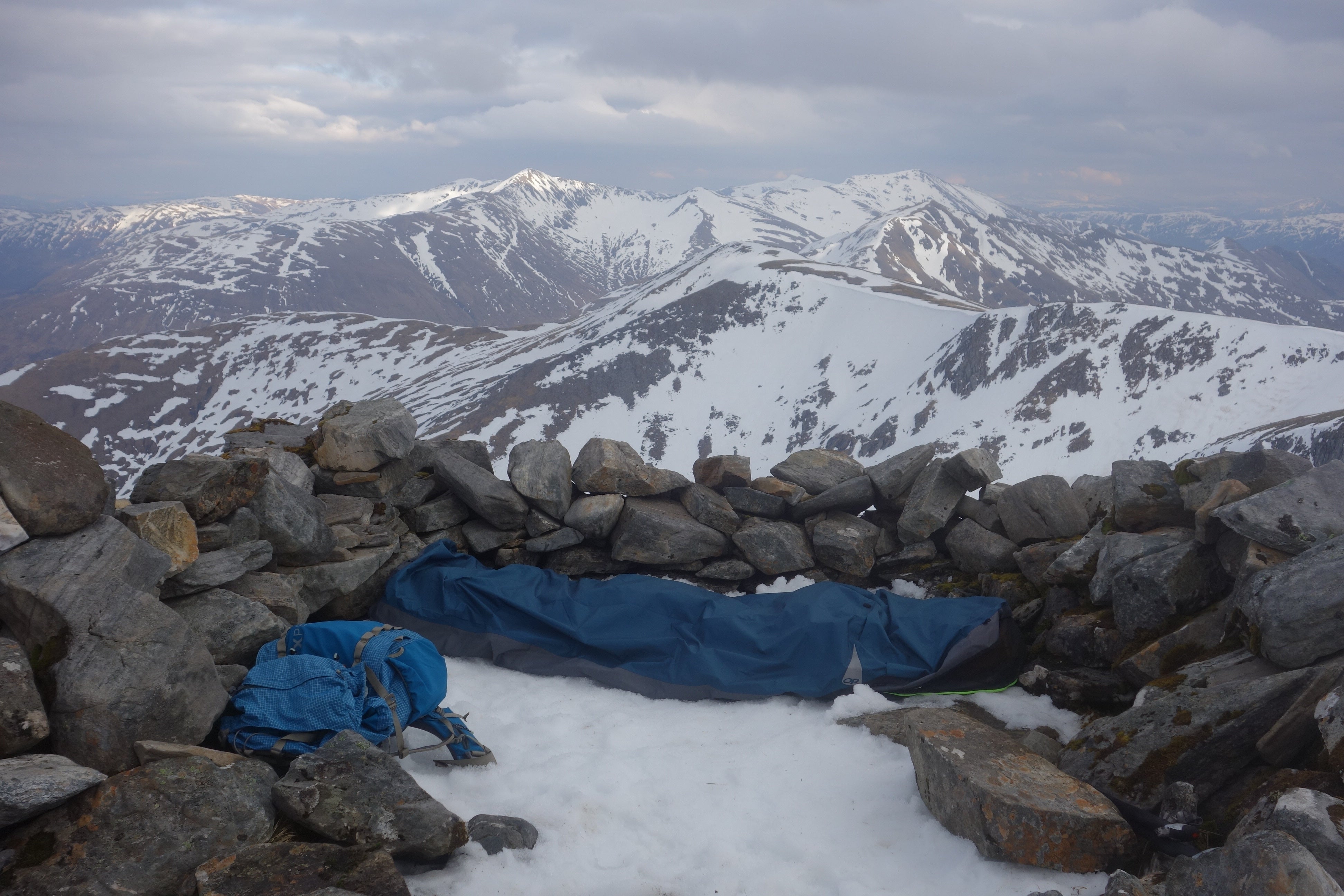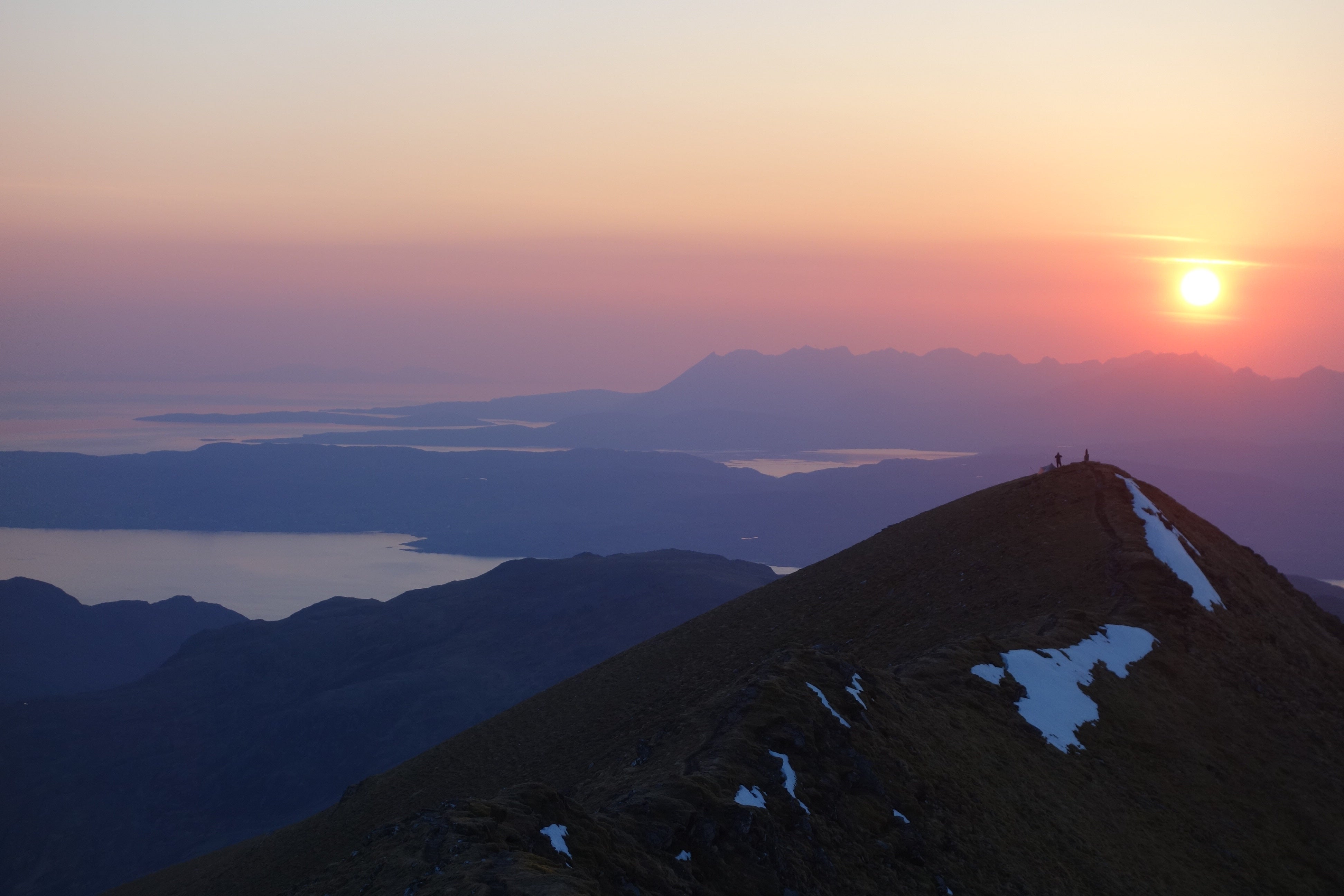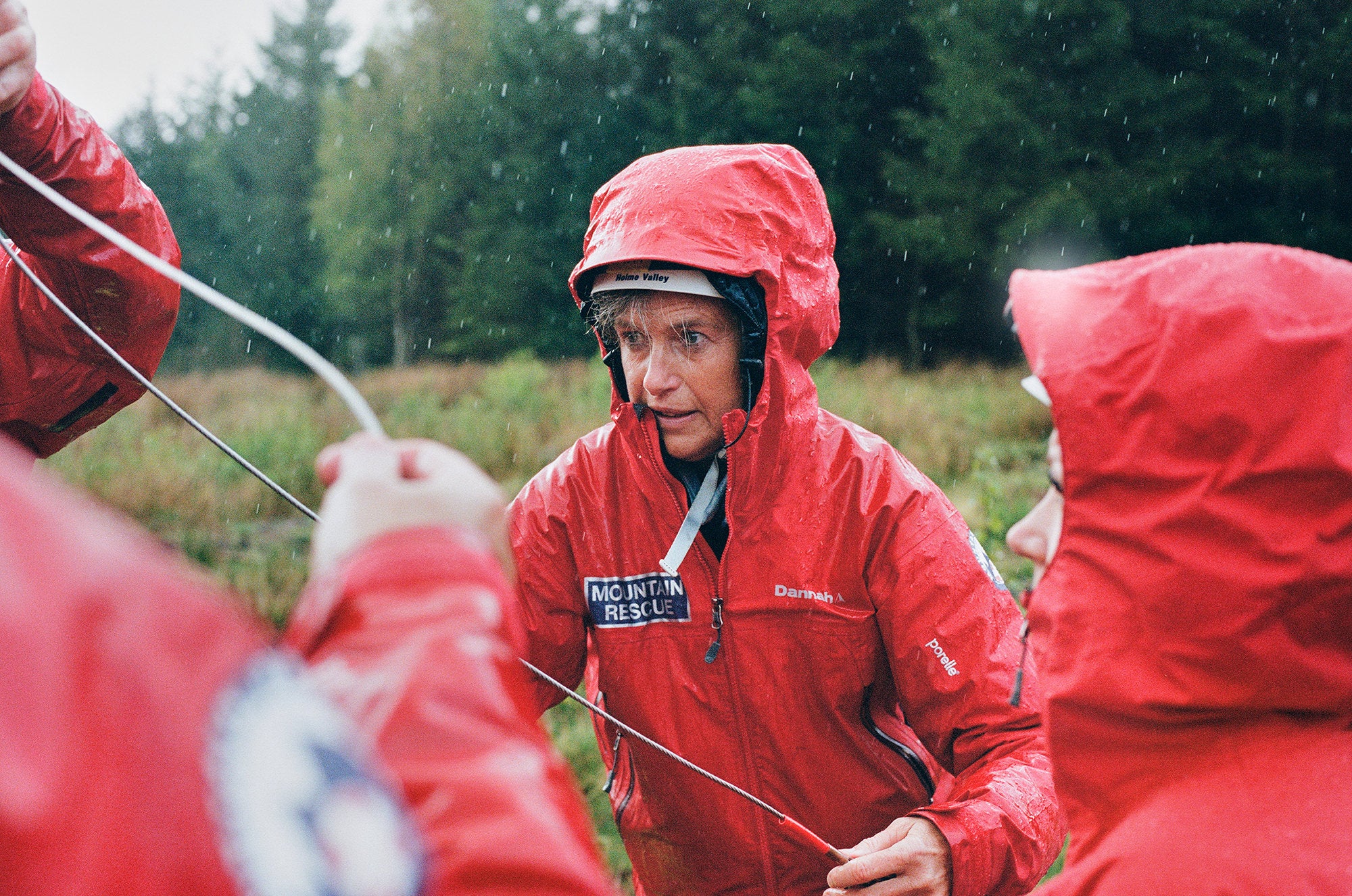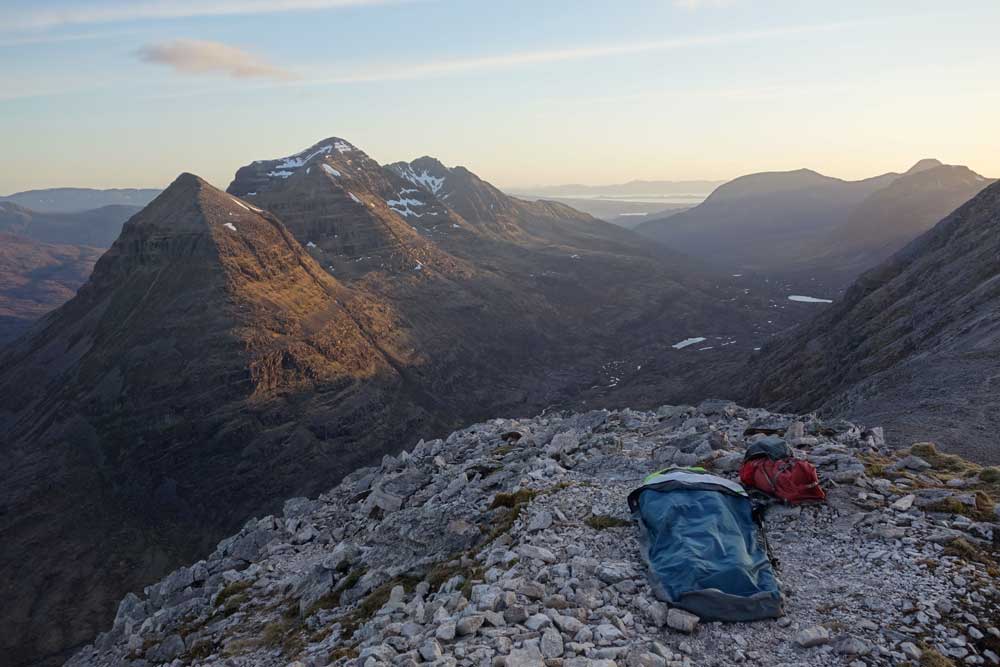Bivvy Bagging
·
Written by Richard Dannah

·
Written by Richard Dannah
Making the most of bivvying on the Scottish Mountains
Insider tips from a bag lady written by Hazel StrachenThe words ‘bivvy’ and ‘Scottish Mountains’ are not very often found in the same sentence which is a pity because a good bivvy is a truly memorable experience.
A bivvy bag is a waterproof cover for a sleeping bag which transforms it into a very rudimental shelter. Space is extremely limited. You’ll fit your sleeping mat to insulate from the ground, sleeping bag, small pillow and yourself into a bag and well, not much else. The word ‘bivvy’ or ‘bivi’ is both a noun and a verb; as a noun it described the bag itself, as a verb ‘bivvy’ is the term given to sleeping out in the open without the aid of a tent in a ‘bivvy’ bag. Bivvying can be used as an exercise in cutting weight from you weekend kit. However, it’s not a survival exercise but it can be if you really want to! I bivvy as a means of connecting with the landscape around me.“The bag was a welcome relief from lugging a tent”
I love the simplicity of a night on the mountains in a bivvy bag, the closeness to nature and the elements; gazing up at the stars and watching the sky change through the night. I love lying on my front gazing out, watching grasses blowing in a soft breeze on a summit ridge; marvelling at small beetles and spiders which I never knew existed in the delicate mosses which grow on the mountain summits. An evening bivvy can be as exciting as a beautiful day stravaiging over the mountains.I bought my first bivvy bag in Alaska for a summer adventure nearly a quarter of a century ago. The bag was a welcome relief from lugging a tent around on short adventures. However I fell back to relying on the tent when I had no idea what the weather would bring. My current bivvy bag, an Outdoor Research ‘aurora’ bag, is a less ‘flashy’ model than my first bag, not that the simplicity of a bivvy bag could ever be described as ‘flashy’.

Dorain & Knoydart April 2017
Bivvy bag v’s Tent and Tarp
There is literally no stopping you from where you can bivvy for a night. The footprint of a bivvy bag is small compared to that of either a tent or tarp. I’ve bivvied on summits, on rocky terraces sheltered from a strong wind, in woods, by rivers, behind boulders, in gorges and on a terrace which was dug out from a snow slope. I couldn’t have erected my tent on a lot of these sites. From a performance point of view, however, a bivvy bag has some issues compared to the reliability of a tent or tarp for shelter. Condensation can, but not necessarily, build up on the inside of the bag and make sleeping bags damp, even when the bivvy bag is made from highly breathable Gore-Tex. Humidity plays a role in the effectiveness of Gore-Tex. Because of this I use a synthetic sleeping bag. If you’re using a down filled sleeping bag make sure it’s a hydroponic one as damp or wet down doesn’t insulate. It’s worth washing your sleeping bag using a technical wash such as Nikwax Techwash to help maintain the DWR coating so that the outer will shed any moisture which you get on your bag from condensation. Bivvys in Scotland are best done for one or two nights unless you have means of airing your sleeping bag. One beautiful March day on the Cairngorm Plateau I aired my sleeping bag by hanging it out of my rucksack whilst I walked as I had to cover a lot of miles that day. If the weather forecast is to be good for several days there is no reason why you couldn’t do the entire trip using a bivvy bag. If you are not counting grams but more interested in performance take a tent or tarp instead. If you dislike being in a small space, you’re not really going to like being cooped up in a bivvy bag.
 Challum bivvy Feb 2018 note the Bin bag
Challum bivvy Feb 2018 note the Bin bagDesign
My ‘Aurora’ bivvy bag is a half and half bag - Gore-Tex upper layer which is highly breathable and a less breathable but waterproof base. This combination of fabrics makes the bag cheaper than buying a full Gore-Tex bag. E-Vent is another good fabric option if you want to push the boat out. You could use an emergency big orange ‘survival’ bag for an impromptu night out if you wish but you will get damp/soggy from your own condensation on the inside of the bag. If you want a cheap bivvy bag to start you off on your adventures there are ex-Army bivvy Gore-Tex bags which can be picked up quite cheaply on eBay. They are larger in size and heavier than any bags made by Outdoor Research, Rab, Exped, Alpkit or Snugpack.Bivvy bags can be hooped, resembling small tents, which creates a little bit more space around your head to keep any claustrophobic feeling at bay. They can be as simple as a bag with a draw cord to tighten up around your face (ideal if you sleep on your back). My bag has a clam shaped opening. I like this design as I sleep on my side and breathe out of the bag. It also gives my face more protection as I can partially zip up the opening to stop weather coming into the bag which is a good idea for Scotland. You cannot breathe into your bag or you will condensate the inside fabric of the bag even more. If I’m feeling claustrophobic I can wedge my air pillow behind my head to create a bit more room. I’m lucky that I have loops on my bag so I can securely peg it down so I’m not caught unaware with it blowing away when I’m away taking photographs. Very few bags have this feature. Please do not place boulders on top of your bag to hold it down as you could damage the fabric.
Sleeping arrangements
It’s best to use a comfortable sleeping mat although in very dry conditions it’s possible to sleep on your rucksack and still get a reasonable night’s sleep (been there, done that and did get a good night’s sleep.) In winter you can spend up to twelve hours in the same small space, believe me comfort is paramount! I use a Exped Down Mat UL and can sleep on my front, side or back in complete comfort. To be honest it’s comfier than my bed at home. My sleeping mat is placed inside my bag. If you are using a full Gore-Tex bag you will sleep in your bag on top of a sleeping mat. 

Bivvy bags and bin bags
If the forecast is for a clearing night and I have to set up in mist or fine drizzle I like to carry a large heavy duty bin bag (rustles less in the wind than a thin bin bag). It’s useful for keeping my kit dry when setting up my bivvy when I’m pulling gear out of the bottom of my rucksack. As I don’t have a rucksack cover I can also use the bin bag to store my rucksack overnight so it doesn’t become sodden from the overnight dew: there is no room in a bivvy bag for storing a rucksack when you are sleeping.Planning a bivvy trip
Flexibility is the key to having a good bivvy experience. I’m always watching weather forecasts, searching out small weather windows of clear evenings and almost windless weather. A time scale can be as short as the time between sunset and sunrise or as long as a prolonged settled period. Aiming for a bivvy on a mountain summit when the cloud is clearing late in the day is more risky for an adventure as the summit may not become free from cloud. Sometimes choosing to sleep out on a satellite summit will guarantee a cloud free night which has happened quite a few times for me. Note the forecasted wind direction – will it change during the night making your bivvy exposed? You can always use your rucksack to deflect the wind from your head. When I start out walking I never know where on a mountain I’m going to be sleeping for the night. I let local conditions decide for me. On Beinn Fhionnlaidh I found a windless spot on a rocky outcrop, two minutes walking further up or down the mountain and the wind was very strong. One January on the South Cluanie Ridge I found a very small hummock on a bealach which deflected the wind - oh boy, it was a ‘warmer’ spot than a summit bivvy would have been! If I have to walk back to an ideal spot I will do so rather than suffer an uncomfortable night.Keeping cool, frozen boots and food
I try to walk cool before a bivvy so as not to get my clothes damp from sweat as I’ll be sleeping in my day clothes; I’ll make sure the bottoms of my trousers are turned up and tucked away behind gaiters and are not getting wet from any damp vegetation I’ll be walking through. If I’m sleeping wearing my trousers I don’t want soggy trouser bottoms creating a cold damp patch in my sleeping bag. The same rule applies to the rest of my clothes. When setting up for the night I’ll put on extra clothes to retain my body heat: it’s easier to stay warm rather than having to generate heat after being cold. When sleeping I’ll wear just enough clothes to feel comfortable to sleep in; too many clothes can feel colder than fewer clothes. Bringing along an extra pair of dry socks or down boots is a worthwhile luxury. A hat or hood is essential. I carry a small pair of barefoot trainers to change into so I can step easily into my bivvy bag instead of performing an elaborate balancing act trying to take my boots off while stepping into my bag. A couple of plastic bags to cover your socks will also suffice. Over the years I still have not taken to wearing frozen boots first thing on a cold morning. I will either stash my boots away in my rucksack or under my air pillow. Having a good warm meal or food intake before crawling into your bivvy for the night – nobody ever had a good night’s sleep on an empty stomach.The worst night…. ever?
I’m starting to think that any luck which may help me to win the National Lottery has been redirected to providing me midge free bivvies. Only three midgies turned up on an August bivvy one evening on Aonach Eagach, the total for an entire summer. A night bivvying in the Scottish mountains could end up being your worst night ever in the mountains. Midgies will start to hatch from early June and stay around till September. The best advice is to keep to high ground and bivvy in a breeze to keep the blighters away. Even then you could still run into some midgies. A bivvy bag with a bug net is a good investment. Repellents like ‘Smidge’ are great for protecting your hands and arms, but a midge net an essential protection for your head – Midgies will crawl up your nose and in your ear canals and I haven’t yet found the courage to spray Smidge up my nose given the advisory notice on the can for where not to apply the repellent. Best of luck!





